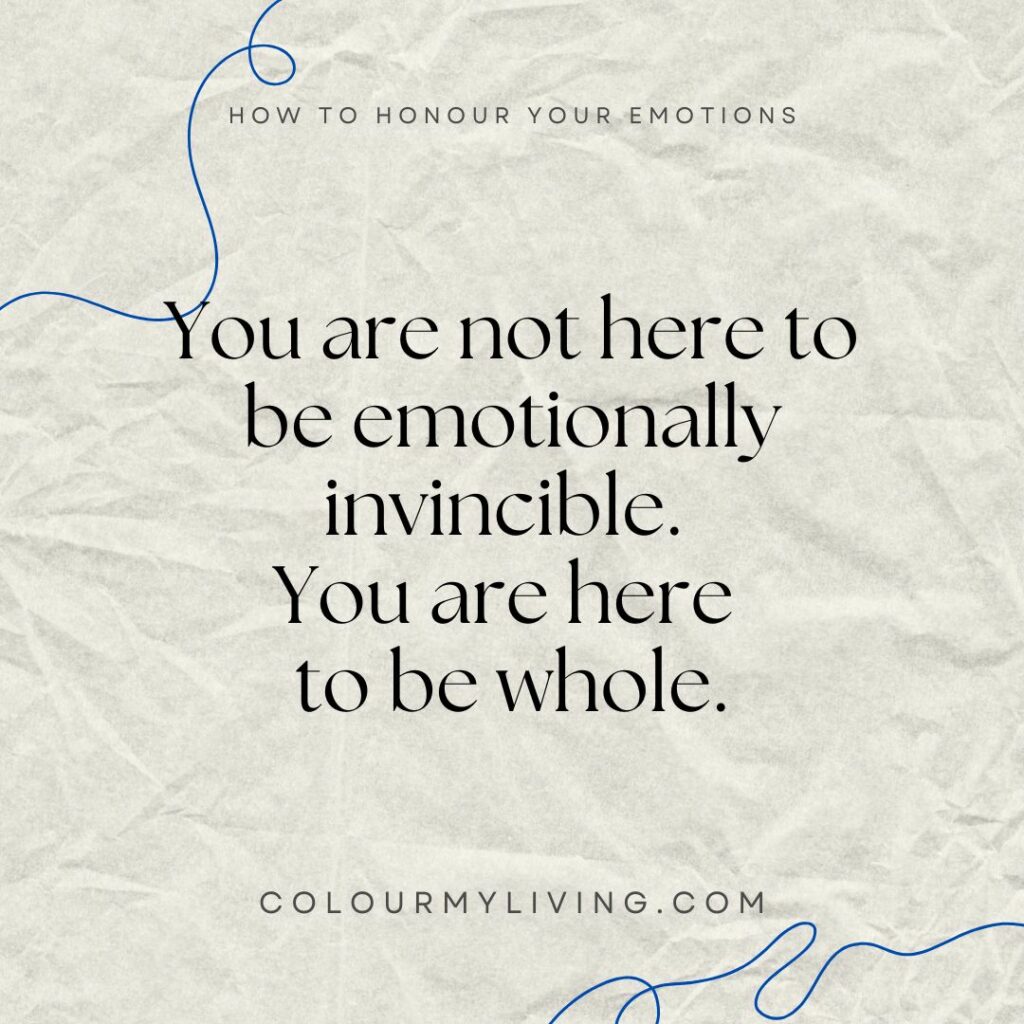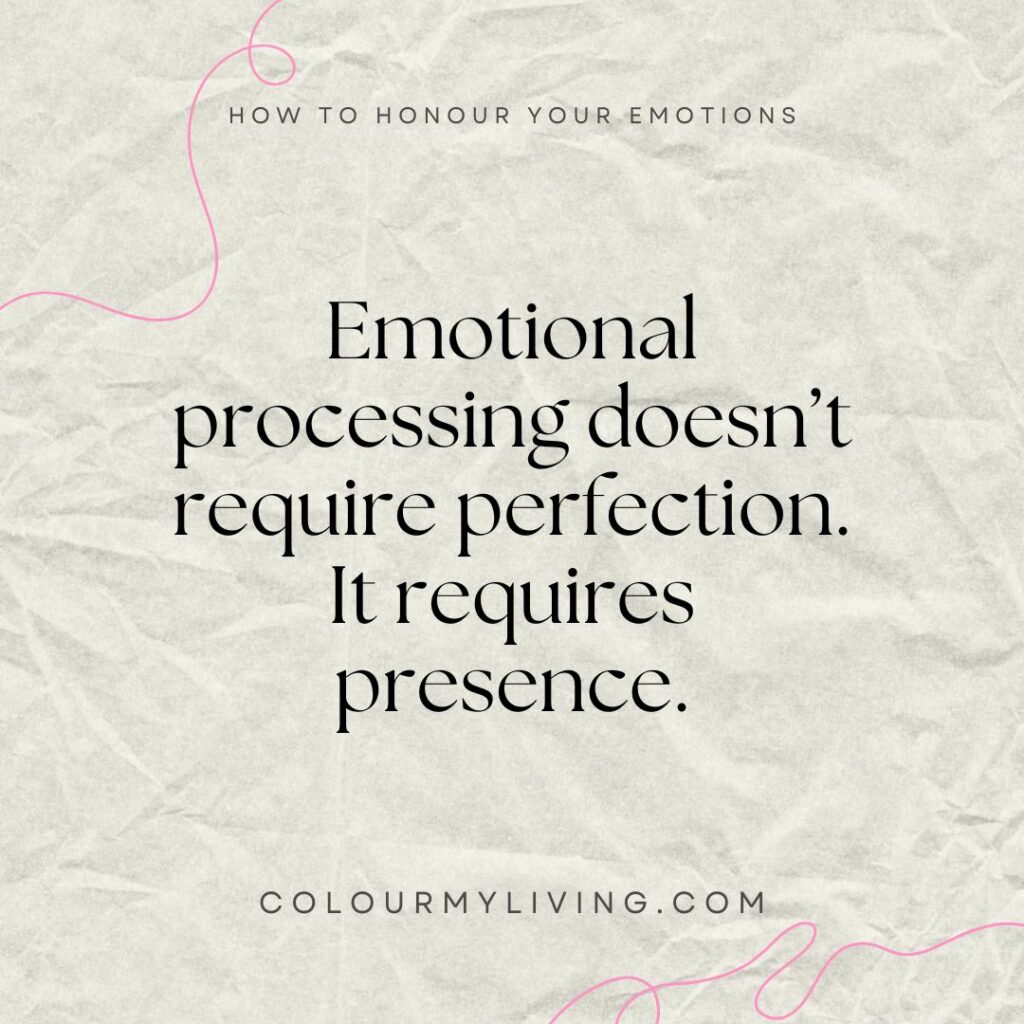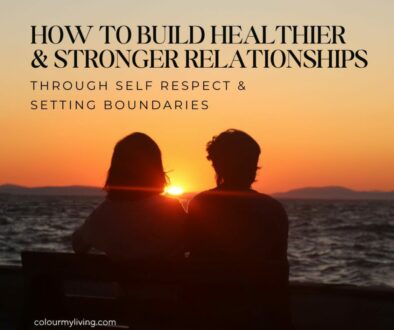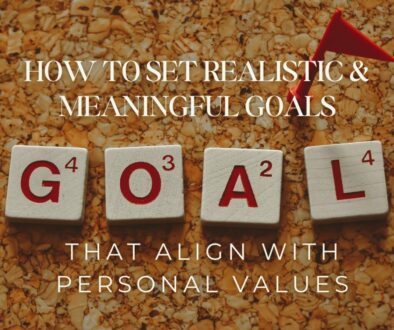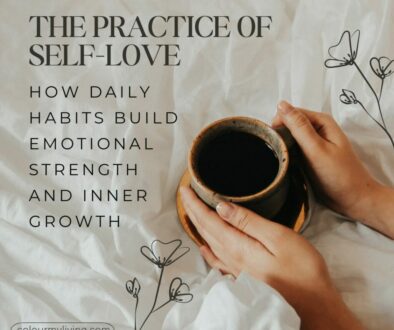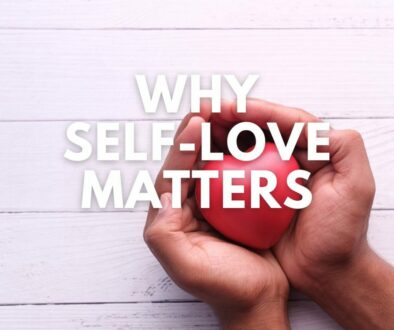How to Honour Your Emotions: A Gentle Guide to Emotional Well-Being and Inner Peace
Have you ever pushed your feelings aside just to make it through the day? Maybe you’ve told yourself to stay strong, to just keep going, or to not make a big deal out of it. You may have smiled when you felt like crying, or buried your overwhelm under yet another to-do list. If that sounds familiar, please know that you’re not alone.
In today’s fast-paced, productivity-driven world, it’s all too common to suppress emotions in the name of efficiency or strength. Add to that the economic and political upheaval of the current season and it becomes routine to slap on a brave smile and keep going on. We are so often taught to simply “get over it,” to move on quickly, or work to stay positive at all costs. The reality is, true emotional well-being isn’t about pretending everything is fine—it truly is about showing up for your feelings with honesty, tenderness, and presence.
Honouring Your Emotions Is Essential, Not Optional
To be able to honour your emotions means to learn to acknowledge what you feel without judgment. It means being able to make space for joy and sorrow, confidence and confusion, energy and exhaustion. It is a learned practice of meeting yourself exactly where you are, with compassion rather than criticism.
When you learn to honour your emotional world, you give yourself permission to live more fully and authentically. You begin to understand that emotions are not flaws to fix, instead they are signals to notice, messages to interpret, and invitations to connect even more deeply with yourself.
This approach is not only essential for emotional health—it actually forms the basis and foundation for personal growth, resilience, and inner peace.
In this gentle, supportive guide, we’ll discuss how to:
- Change your emotional focus with the power of gratitude
- Build emotional stability through daily, intentional self-care
- Process and express emotions in ways that support clarity and calm
- Embrace the natural cycles of your inner emotional world without fear or shame
Whether you’re navigating a heavy season or simply seeking more balance, these practices will definitely help you reconnect to yourself and create a more compassionate relationship with your emotions.
Let’s begin—gently, one feeling at a time.
1. Why Honouring Your Emotions Is an Act of Self-Love
Many of us were never taught how to truly honour our emotions. From a young age, we absorb subtle and not-so-subtle messages about which feelings are “okay” to express—and which ones are better kept quiet. Joy is welcomed. Gratitude is celebrated. But sadness? Anger? Fear? Those emotions often get labelled as too much, too dramatic, or even inappropriate.
As a result, we learn to mask our discomfort with a smile, to apologise for our tears, or to silence our inner world so that we don’t rock the boat. Over time, this habit of emotional suppression literally disconnects us from ourselves. We lose the ability to read the signals our feelings are trying to send.
But here’s the truth: every emotion you experience carries valuable information.
- Sadness might be inviting you to grieve and slow down.
- Anger could be pointing to a boundary that’s been crossed.
- Anxiety may be signalling a need for safety, clarity, or rest.
When you ignore or suppress these signals, they don’t actually just disappear. They go underground—buried in your body, stored in your nervous system, and often when you least expect it, they re-emerge as stress, burnout, irritability, or numbness.
Flip the script
Being able to honour your emotions is to be able to flip the script. Instead of seeing emotions as inconvenient or wrong, begin to see them as intelligent and deeply human. You learn to shift from pushing feelings away to welcoming them as guests with something to teach you.
This practice isn’t always easy, especially if you’re used to brushing your emotions aside in order to “get things done” or keep others comfortable. Over time and with practise, it becomes one of the most powerful and transformative forms of self-love you can offer yourself.
Honouring your emotions means:
- Listening, even when it feels uncomfortable
- Validating, rather than dismissing what you feel
- Responding with compassion instead of reacting from fear
It is an act of inner loyalty—a way of saying,
“My experience matters. My feelings are valid. I deserve to be heard—even by myself.”
And the beautiful ripple effect?
When you learn to honour your own emotions, you naturally extend that same care and consideration to others. You begin to create a life that is not only emotionally balanced but deeply rooted in empathy, presence, and self-respect.
2. Practise Gratitude to Shift Emotional Focus
Why Gratitude Supports Emotional Well-Being
While it’s vital to create space for difficult emotions like sadness, anger, or fear, it’s equally important to stay connected to what is nourishing, grounding, and good. Gratitude is one of the most powerful ways to do that.
At its heart, gratitude is not just about ignoring or masking over pain—it really is about creating balance. It invites us to notice the small joys, quiet comforts, and meaningful moments that are often overlooked in the rush of daily life. It shifts our attention from what is lacking to what is present—from whatever we believe to be broken to the things that are actually holding us strong and together.
This simple yet important practice does not demand a perfect life. Instead, it asks a gentler question:
“What, even now, can I be thankful for?”
Scientific research supports what many of us instinctively feel: gratitude helps us feel more grounded, resilient, and connected.
- Psychologists Robert Emmons and Michael McCullough found that regular gratitude practice increases emotional resilience and overall happiness.
- Studies also show that gratitude reduces symptoms of anxiety and depression, lowers stress levels, and deepens relational bonds.
- Positive psychology expert Martin Seligman found that practicing gratitude significantly boosts life satisfaction and optimism over time.
But perhaps even more importantly, gratitude brings us back to ourselves. It reminds us that peace is not only found in grand milestones, but in everyday tenderness—a warm conversation, a deep breath, a beam of sunlight through the window.
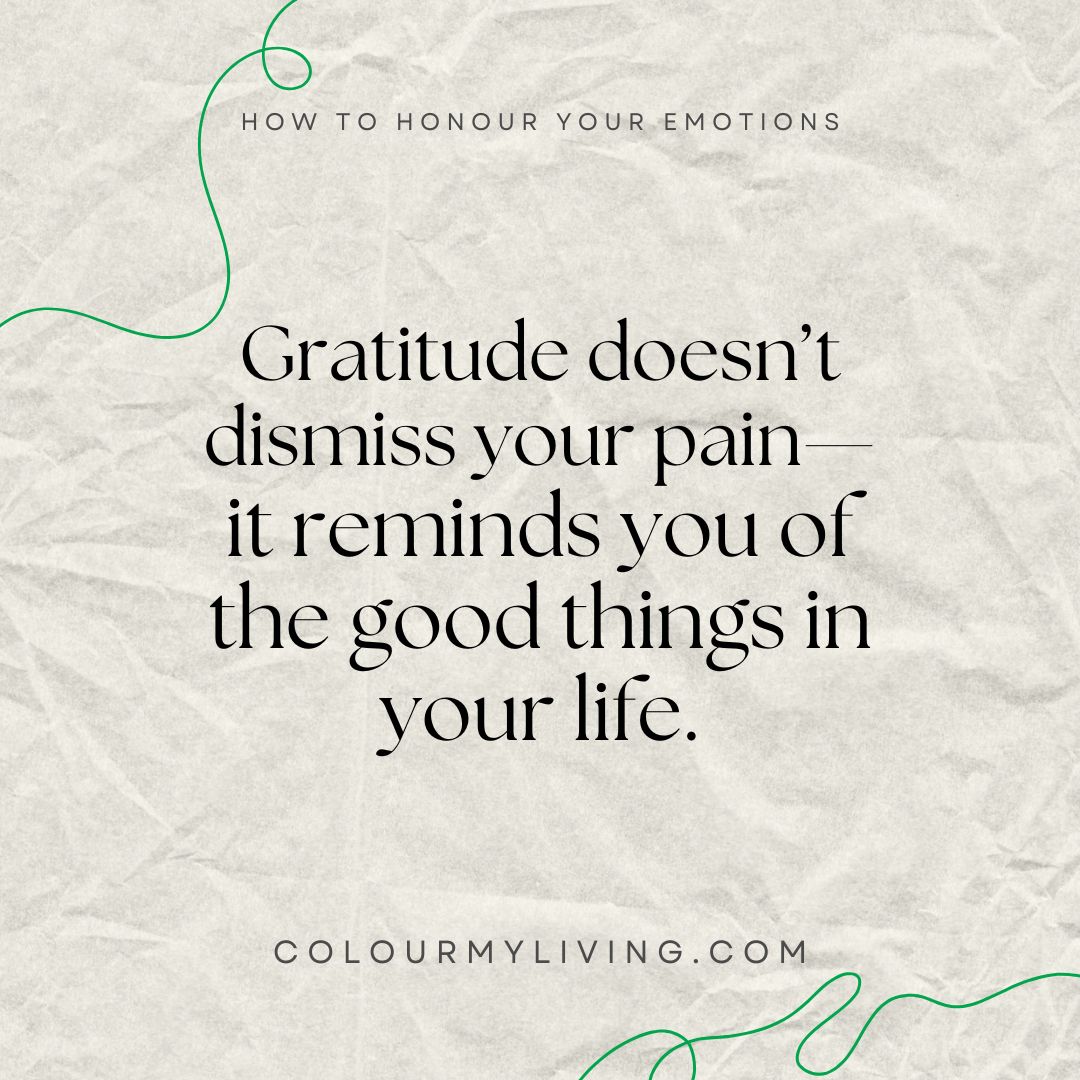
How to Make Gratitude a Gentle Daily Habit
You don’t need a journal full of poetic entries or long lists to feel the benefits of gratitude. What matters most is consistency and sincerity. Gratitude, when practiced daily, becomes a thread of steadiness through emotional ups and downs.
Here are a few simple ways to begin:
- Start with three daily gratitudes. These can be small moments—like the smell of coffee in the morning, a smile from a stranger, or a song that lifted your mood.
- Be specific and personal. Instead of saying, “I’m grateful for friends,” try “I’m grateful for the thoughtful voice note from Sarah that reminded me I’m not alone.”
Use gentle prompts to guide your focus:
- What made me smile today?
- What gave me a sense of peace or comfort?
- What helped me feel connected, seen, or supported?
You can write your gratitude down in a notebook, say it out loud, or simply pause to hold it in your mind for a few moments of stillness. What matters most is presence—the act of consciously choosing to see what is here and good, even when life feels uncertain.
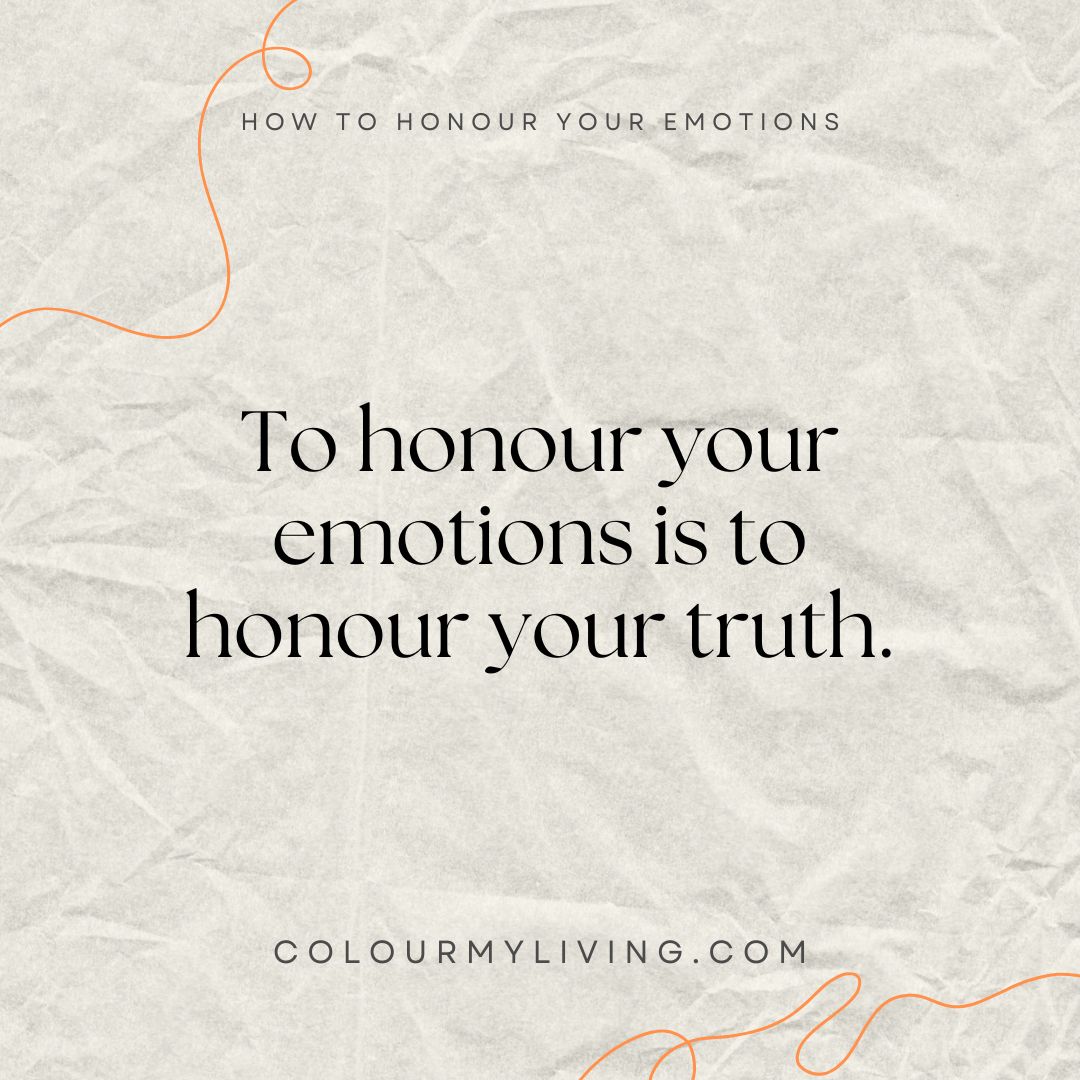
Reflection Prompt:
What is one thing you’re thankful for today that you might have overlooked yesterday?
Let it rise gently. Let it ground you.
3. Prioritise Self-Care to Support Your Emotional Landscape
When we talk about emotional well-being, the conversation often starts with how we feel. But just as important is how we care for those feelings—how we create space, offer nourishment, and build supportive routines that sustain our inner world. This is where self-care becomes essential.
Too often, self-care is misunderstood as indulgence—a spa day, a treat, a break from “real life.” But in truth, self-care is not a luxury. It is emotional maintenance that ensures that we stay resourced, resilient, and connected to ourselves in a world that’s constantly asking for more.
When you regularly honour your needs—physical, emotional, mental, spiritual—you send yourself a powerful message:
“I am worth showing up for.”
Why Self-Care Is Emotional Maintenance
Think of your emotional well-being as a reservoir. Every time you give energy, face a challenge, or process a difficult emotion, you draw from that reservoir. If you are not also refilling it—through rest, nourishment, joy, and clear boundaries—eventually, it runs dry.
The signs of emotional depletion often appear gradually:
- You feel easily irritated or overwhelmed
- You struggle to concentrate or make decisions
- You feel emotionally numb or disconnected from your body
- You lose motivation, joy, or the sense of being “yourself”
These are not signs of weakness. They are signals—clear and valid indicators that your inner world is asking for attention, support, and care.
By making time for self-care, even in small moments, you begin to rebuild your inner stability. You anchor your nervous system. You regain clarity. And you remember that you are not just surviving—you’re allowed to feel supported and at ease.
Types of Self-Care That Support Your Emotions
Self-care is not a one-size-fits-all solution. It is a deeply personal practice that has to reflect what you need in order to feel whole and steady. It may change from day to day, or season by season—and that is perfectly normal and natural.
Here are some gentle categories to help you explore what might serve you best:
Emotional self-care: Journaling, working with a therapist or coach, practicing self-compassion, allowing yourself to cry or feel without rushing to “fix” it
Mental self-care: Taking breaks from screens or social media, creating space to read, learn, or reflect, allowing time to unplug from overstimulation
Physical self-care: Moving your body in ways that feel nourishing (a walk, yoga, dancing), prioritising rest, drinking water, eating foods that make you feel well
Social self-care: Spending time with people who feel safe, uplifting, and real; saying no to draining dynamics or one-sided connections
Spiritual self-care: Moments of stillness, time in nature, breathwork, prayer, or connecting with something bigger than yourself—whatever that may mean to you
These practices are not about perfection or performance. They’re about support—building a life that holds you as much as you hold everything else.
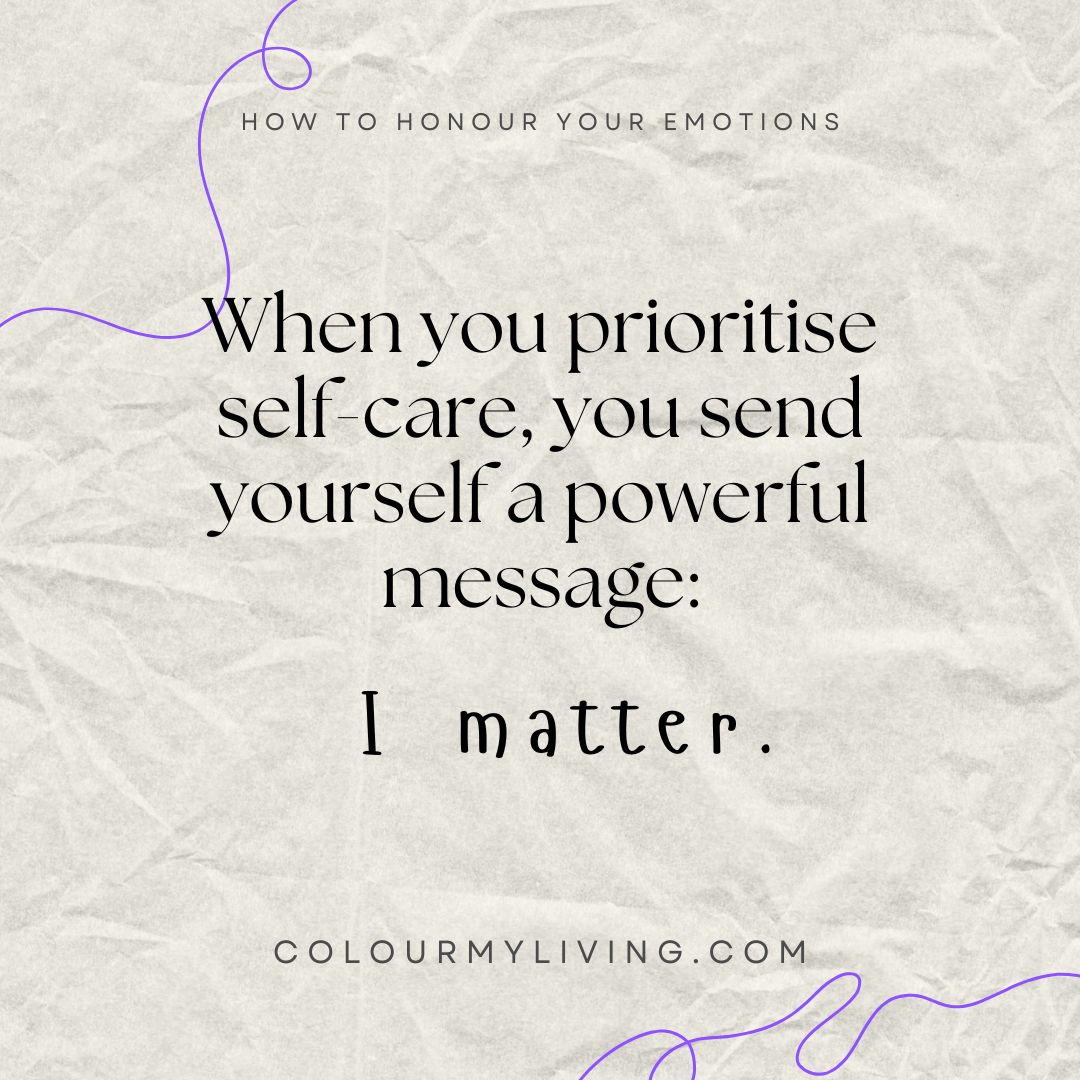
Make Self-Care Daily, Not Occasional
One of the most common misconceptions about self-care is that it has to be big, time-consuming, or expensive. But self-care definitely is not about doing more—it is about pressing Pause to check in and do whatever is required.
Small, consistent acts have the greatest impact. You might try:
- A few minutes of quiet before the day begins
- A walk outside to clear your thoughts
- Saying “no” to a plan or task that would overextend you
- Putting your phone away while you eat, so you can be present with your body
- Choosing a nourishing dinner over convenience food, not because you “should,” but because you care
These moments may seem small, but they are so important. They reinforce a new story. One that says:
“I am worth care. I am worth time. I am allowed to rest.”
When you prioritise self-care, you send a powerful message, especially to yourself: I matter.
4. Learn to Process and Express Emotions in Healthy Ways
When emotions feel big or overwhelming, it is natural to want to avoid them. We might distract ourselves, push through, or tell ourselves that “now isn’t the time.” And while there are moments when temporary coping is necessary, emotions that are never acknowledged don’t simply fade away—they actually do go somewhere. Unfelt feelings build up in the body and mind, showing up later as irritability, fatigue, anxiety, or even physical tension.
Emotional processing is not about fixing how you feel. It is about creating space to allow you to feel what is present, and to let those emotions move through you safely and gently. It is a practice of giving yourself permission to pause, reflect, and respond—with compassion instead of judgment.
Why Naming and Feeling Emotions Matters
There’s a huge difference between being engulfed by an emotion and being able to take the time to name it. When you pause and say, “I feel anxious,” “I feel lonely,” or “I feel overwhelmed,” you bring awareness to your internal experience. That moment of naming often softens the emotion’s grip—it then helps you to step back and observe rather than be consumed by it.
In psychology, this is sometimes called affect labeling—and studies show that naming your emotions reduces activity in the amygdala (the brain’s alarm system), while increasing activity in the prefrontal cortex (responsible for logic and decision-making). In simple terms: naming an emotion helps calm your nervous system and restore clarity.
When you give your emotions the attention they ask for, you begin to experience:
- Greater clarity about what you truly need
- Deeper self-awareness and emotional intelligence
- A natural sense of relief and emotional release
- Less reactivity and more thoughtful responses
Emotional processing doesn’t require perfection. It requires presence.
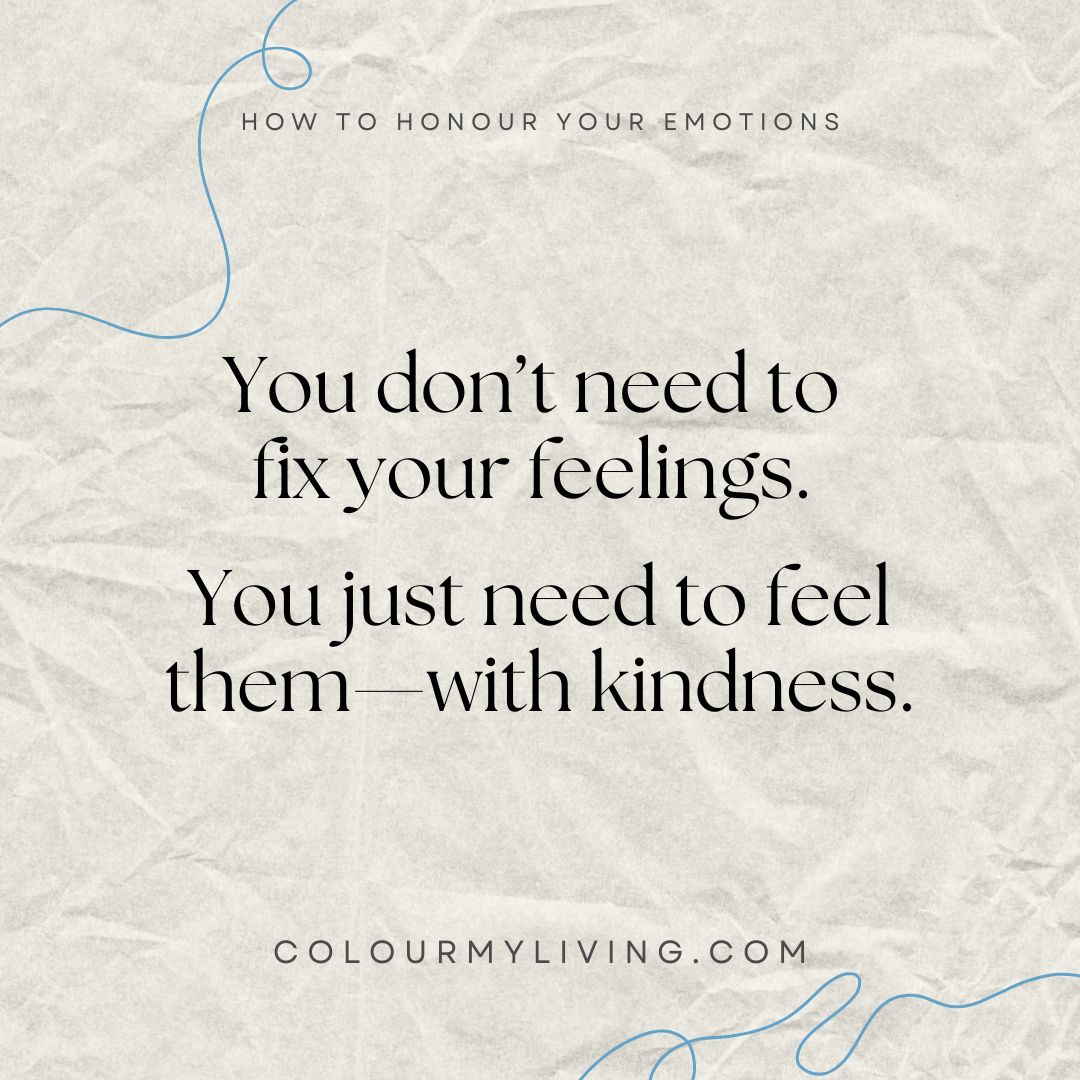
Tools to Support Healthy Emotional Expression
There are many ways to process and express emotions—some quiet and reflective, others creative and embodied. The key is to find what feels supportive for you in the moment.
Here are a few gentle, practical tools to explore:
- Emotional check-ins Pause throughout the day to ask: “What am I feeling right now?” “Where do I feel it in my body?” “What might this emotion be trying to tell me?” These micro-moments of awareness reconnect you to your inner world.
- Journaling Write without editing or censoring. Let your thoughts flow freely. You might start with: “Right now, I feel…” or “What I really need is…” Over time, journaling can help you spot emotional patterns and deepen your self-understanding.
- Creative outlets Sometimes words aren’t enough. Art, music, dance, and poetry allow emotions to move through you in ways that feel expressive and cathartic—without needing explanation.
- Breathing techniques When emotions feel overwhelming, breath is your anchor. Try box breathing to regulate your nervous system: Inhale for 4, hold for 4, exhale for 4, hold for 4—repeat for a few cycles. This can help bring calm and presence back to your body.
- Support systems Talk to someone who holds space without judgment. Whether it’s a friend, therapist, or trusted mentor, sharing your emotions aloud often brings clarity and relief. You don’t need to “fix” anything—just being heard is healing.
- Reframe your self-talk Language matters. Move away from identifying as the emotion to acknowledging the experience. Instead of: “I’m anxious,” try: “I’m experiencing anxiety right now, and I can support myself through it.” This subtle shift reminds you that emotions are temporary states—not definitions of who you are.
Gentle Reminder
Emotions are not permanent. They are waves—sometimes big, sometimes small, but always moving. You don’t need to stop the wave. You only need to ride it with steadiness and care.
5. Honour Your Emotional Rhythms and Seasons
Just as the earth moves through cycles of light and shadow, bloom and rest, you too will have emotional seasons—natural shifts in energy, clarity, and emotion. Some days feel expansive and energised, filled with clarity and motivation. Others are quiet, tender, or foggy. These fluctuations are not a sign that something is wrong. They are signs that you are alive—deeply human and in tune with the subtle changes within.
Yet in a world that celebrates consistency, productivity, and emotional “stability,” it’s easy to misinterpret these ebbs and flows as failures. We are told that we need to be the same every day—to show up, smile, perform, and keep going. But just as nature doesn’t bloom all year long, neither can we.
Honouring your emotional rhythms means learning to live in harmony with your inner world, not against it. It’s about tuning in, adjusting gently, and releasing the unrealistic expectation that you must feel the same way every day.
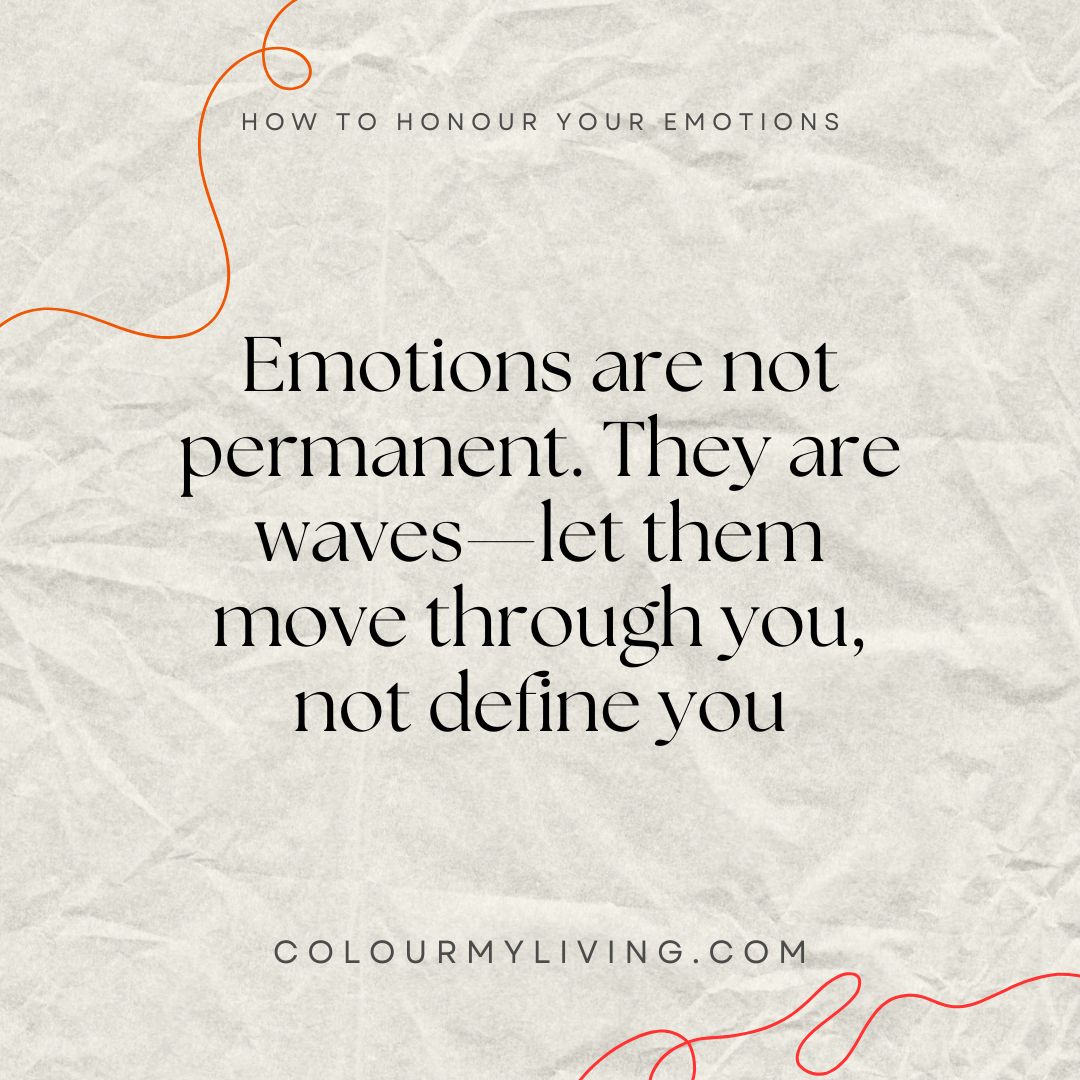
Emotions Move in Cycles, Not Straight Lines
Your emotional landscape is not a checklist to complete or a problem to solve—it’s a cycle to observe. There will be days when you feel joyful and connected, and others when you feel low, scattered, or withdrawn. That’s not regression—it’s rhythm.
Stillness doesn’t mean you’re failing. Sadness doesn’t mean you’re broken. And uncertainty certainly doesn’t mean you’ve lost your way. These are all parts of your internal seasons—and each one has wisdom to offer.
How to Honour Your Inner Rhythm
Learning to honour your emotional rhythm begins with listening. You don’t need to control your mood—you simply need to check in with compassion.
Here’s how that might look in daily life:
- Start with a daily check-in Ask yourself simple, grounding questions like: “What am I feeling today?” “What kind of energy is present in me?” “What would feel supportive right now—movement or stillness? Connection or solitude?”
- Adjust your expectations If your inner world feels heavy or tender, it’s okay to slow down. You can reschedule a task, take a shorter walk, or give yourself more space to rest. When you align your actions with your emotional state, you reduce inner resistance and create more ease.
- Let go of emotional perfectionism There is no “right” way to feel. Every emotion you experience is part of the full, vibrant spectrum of being human. Embracing all of it—without rushing to change or justify—creates emotional safety within yourself.
- Use your rhythms as insight If you feel particularly low at certain times (e.g. during the evening, after social interactions, around hormonal cycles), note these patterns. Over time, you can anticipate them and offer yourself more proactive care.
Ask Yourself: What do I need today? Is it movement or rest? Connection or quiet? Productivity or pause? Let your body and emotions guide you—not your calendar or your to-do list.
By respecting your emotional seasons, you build trust with yourself. You begin to live from a place of self-honouring rather than self-pressure. And in doing so, you create a life that is more sustainable, balanced, and rooted in deep inner awareness.
Final Thoughts: Create Space for Every Emotion
Emotional well-being is not about striving for constant calm, endless joy, or perfect poise. It’s not about eliminating discomfort or suppressing sadness. Instead, it’s about learning to move through your emotions with awareness, compassion, and care. It’s about showing up for yourself, again and again, no matter what you’re feeling.
When you honour your emotions, you honour your truth. You create space for your whole self—not just the parts that feel polished or “put together,” but also the parts that are tender, raw, uncertain, and evolving. You step away from the exhausting pressure to perform or please and begin to live from a place of honesty, alignment, and deep self-respect.
There is no gold star for being emotionally invincible. There is only the quiet, profound strength that comes from being emotionally honest. To gently recap the emotional practices we’ve explored:
- Gratitude grounds you in the good—reminding you that even amidst challenge, moments of beauty, love, and comfort still exist.
- Self-care restores your internal balance—helping you return to a place of steadiness and self-support, no matter what life brings.
- Emotional processing creates clarity and release—allowing feelings to move through you instead of defining or controlling you.
- Honouring your emotional rhythms builds trust in yourself—inviting you to live in harmony with your inner landscape rather than resisting it.
Together, these practices form a foundation of emotional resilience. They don’t promise a life without struggle—but they do offer you the tools and self-awareness to move through each experience with grace.
You don’t need to fix your feelings. You just need to feel them—with kindness.
So today, offer yourself the same compassion you would extend to a friend. Let your emotions breathe. Let them speak. And trust that you are strong enough—and soft enough—to hold space for it all.
References
- Emmons, R. A., & McCullough, M. E. (2003). Counting blessings versus burdens: An experimental investigation of gratitude and subjective well-being in daily life. Journal of Personality and Social Psychology, 84(2), 377–389. https://doi.org/10.1037/0022-3514.84.2.377
Key Findings: Individuals who kept gratitude journals reported higher levels of well-being, more optimism, and fewer physical symptoms. - Seligman, M. E. P., Steen, T. A., Park, N., & Peterson, C. (2005). Positive Psychology Progress: Empirical Validation of Interventions. American Psychologist, 60(5), 410–421. https://doi.org/10.1037/0003-066X.60.5.410
Key Findings: Gratitude exercises, like writing a gratitude letter, significantly improved happiness and reduced depressive symptoms over time.
